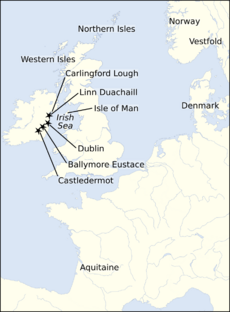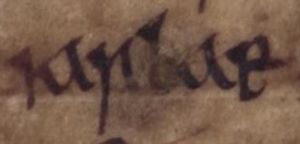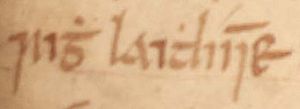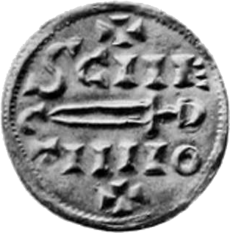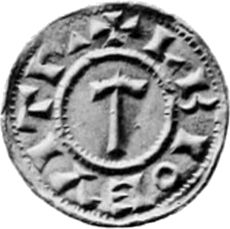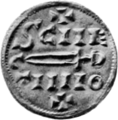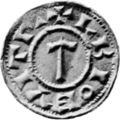Tomrair facts for kids
Quick facts for kids
Tomrair
|
|
|---|---|
Tomrair's name and titles as they appear on folio 318r of Dublin Royal Irish Academy C iii 3 (the Annals of the Four Masters).
|
Tomrair (died 848) was an important Viking leader in Ireland during the 800s. He is one of the first Vikings mentioned in Irish history books. Tomrair was killed in a big battle called Sciath Nechtain in 848. In this battle, 1,200 Vikings were defeated. They fought against the armies of Ólchobar mac Cináeda, King of Munster and Lorcán mac Cellaig, King of Leinster.
Old stories about Tomrair call him an erell. This means he was the first earl mentioned in Irish records. The word erell is actually the first Nordic word borrowed into the Irish language. Tomrair was also called the tánaise ríg of Laithlind. This title could mean he was either the next in line to be king, or a powerful helper to the King of Laithlind. The stories about Tomrair's death are the first time the title tánaise ríg appears in Irish history. We don't know exactly who the King of Laithlind was, or even where Laithlind was located.
We are not completely sure about the events leading up to Tomrair's death. The year after he died, the King of Laithlind reportedly sent Vikings to fight other Vikings already living in Ireland. Later, a group of Vikings called Dubgaill fought another group called Finngaill. In 853, a Viking named Amlaíb arrived. He was said to be the son of the King of Laithlind. Amlaíb took control of the Vikings in Ireland and collected taxes from the Irish. We don't know if the Vikings from Laithlind were the same as the Finngaill or Dubgaill. Later, three Vikings seemed to share the kingship of Dublin: Amlaíb, Ímar, and Auisle. They might have been related, and Tomrair could have been related to them too.
The year Tomrair died was special because the Irish won many battles against the Vikings. Tomrair was a very important Viking leader. His defeat might be what a Frankish history book from 848 was talking about. It said the Irish won a big victory. A collection of Carolingian coins found in Mullaghboden might have been hidden when Tomrair was defeated. These coins were probably stolen from Aquitaine by Vikings from Vestfold a few years earlier.
Tomrair might also be connected to the "ring of Tomar." This ring was stolen from Dublin in 994, along with the "sword of Carlus." These items seemed to be important symbols of the kings of Dublin. They might have belonged to the Uí Ímair family, who were descendants of Ímar. Around the same time, Irish poems called the people of Dublin the "race of Tomar" and "Tomar's nobles." If these names don't refer to Þór, a Norse god, they might refer to Tomrair.
Contents
Tomrair's Death and What Happened Next
Tomrair died in 848. His death is mentioned in several old Irish history books, like the Annals of Inisfallen and the Annals of Ulster. These books say that Tomrair, who was called an earl and the tánaise ríg of Laithlind, died with 1,200 Vikings. This happened at the Battle of Sciath Nechtain, which was likely fought in a place called Skenagun. Tomrair's army fought against the combined forces of two powerful Irish kings: Ólchobar mac Cináeda, King of Munster and Lorcán mac Cellaig, King of Leinster.
The King of Laithlind might be the same as the King of the Foreigners mentioned in Irish history the next year. This king reportedly sent a large fleet of 140 ships to Ireland. They came to fight Vikings who were already living there. In 851, a group called the Dubgaill arrived in Dublin. They defeated the Finngaill there and again at Linn Duachaill. The next year, the Dubgaill beat the Finngaill once more at Carlingford Lough.
In 853, Amlaíb, the son of the King of Laithlind, arrived in Ireland. The Vikings in Ireland accepted him as their leader, and the Irish paid him tribute (taxes). These are the first specific mentions of Amlaíb, but he might have led the Vikings from Laithlind in earlier fights.
Who Was Tomrair?
Family and Importance
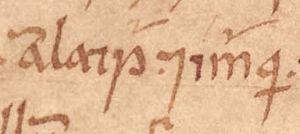
After these events, Dublin seemed to be ruled by three kings: Amlaíb, Ímar, and Auisle. There's a good chance they were brothers. An old book called the Fragmentary Annals of Ireland says they were brothers. It also says that Amlaíb and Ímar's father was a man named Gofraid.
Many of Ímar's later family members, known as the Uí Ímair, had names like Albdann, Amlaíb, Auisle, and Ímar. This suggests they were all related. If Ímar was the same person as Ingware, a leader of the Viking Great Army in England, then other brothers might include Albdann and another Viking leader killed in 878. These two are called Ingware's brothers in the Anglo-Saxon Chronicle.
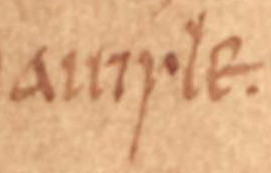
Tomrair himself could have been another brother. In any case, Tomrair was likely part of the royal family of Laithlind, and possibly related to Amlaíb. The Fragmentary Annals of Ireland gives Ímar a long family tree. Even if it's not fully accurate, Gofraid, the supposed father of Amlaíb and Ímar, was probably a real person. He might be the same King of Laithlind whose death is recorded in the Fragmentary Annals of Ireland. We still don't know for sure who the King of Laithlind was, but it's clear Tomrair was a very important man. He is one of the first Vikings mentioned by name in Irish history.
The first time the Irish title erell (which later became ı́arla) appears is when Tomrair's death is reported in the Annals of Ulster. This word means "earl" and comes from the Old Norse word jarl. It's the first Nordic word ever recorded in Old Irish. The Viking title jarl meant a king's helper or deputy. This person had some kind of royal power over a certain area.
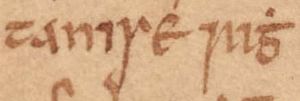
The historical accounts of Tomrair are the earliest mentions of the title tánaise ríg. This Irish title is given to Tomrair in several old books. Its exact meaning is not certain. It could mean "the one awaited by a king," "heir," or "chosen successor." It could also mean "deputy," "military second-in-command," or "second in power to a king."
Where Was Laithlind? And Who Were the Dubgaill and Finngaill?
The story of Tomrair's death is the first time the word Laithlind appears in Irish history books. We don't know exactly where Laithlind was in the 800s. It might have been a Viking-controlled area in Scotland, the islands north and west of Scotland, or the Isle of Man. Another idea is that it referred to Norway, or a part of Norway. Later, the word Laithlind was replaced by Lochlainn. We don't know if they meant different places originally or if they just became mixed up. The fact that Tomrair was called the tánaise ríg of Laithlind, and Amlaíb was the son of the King of Laithlind, suggests that Laithlind was seen as a real kingdom, not just a vague area.
The events from 848 to 853 can be understood in different ways. One idea is that the Vikings from Laithlind were the first Vikings in Ireland. They might have taken back control after the Dubgaill took over for a short time. If this is true, Tomrair's death in 848 might have led the Dubgaill to attack in the early 850s. This then caused the King of Laithlind to send an invasion in 853 to get back control in Ireland.
Another idea is that the Dubgaill and the Vikings from Laithlind were the same group. This group might have defeated Vikings who were already living in Ireland. In either case, the terms Dubgaill and Finngaill might refer to the order in which Vikings arrived. So, Dubgaill might have been a way to describe a new group of Vikings, different from the older group called Finngaill.
The exact meanings of the Irish terms Dubgaill and Finngaill are not certain. Dubgaill literally means "Dark Foreigners," and Finngaill means "Fair Foreigners." It's possible these terms referred to different groups of people, like Danes and Norwegians. But they might also have referred to different Viking power groups in Britain and Ireland. For example, Dubgaill might have meant Vikings led by Ímar's family and friends. Finngaill might have meant an older group of Vikings in Ireland before the Dubgaill arrived. Amlaíb and Ímar might have been related, or they might have just made a deal as leaders of opposing groups. So, Ímar might have led the Dubgaill, and Amlaíb might have led the Finngaill. If this is true, Amlaíb's arrival after the Dubgaill attack might have led to peace between the two groups.
If the stories about Tomrair, Amlaíb, and the Vikings of Laithlind mean that the Norwegian royal family was involved in Ireland, then Tomrair might have been in charge of Dublin. The King of Laithlind might have wanted to take back control of Dublin after Tomrair died. The Vikings from Laithlind might have acted to get back an important trading center. This suggests that Viking trading towns like Dublin were started by powerful groups in Scandinavia, not just by independent Vikings. The fights between the Finngaill and Dubgaill could show competition to control these trading places. This conflict between Danish and Norwegian interests in the Irish Sea area might also have been an early step in Norway becoming a strong kingdom.
The "Ring of Tomar"
Over many centuries, the Uí Ímair family held royal power in the Irish Sea region. They might have used special royal symbols to show their right to rule. For example, in 994, when Dublin was attacked by Máel Sechnaill mac Domnaill, King of Mide, Irish history books say that the Irish took the "sword of Carlus" and the "ring of Tomar" from the people of Dublin. In 1029, a man named Mathgamain ua Riagáin captured Amlaíb, the son of Sitriuc mac Amlaíb, King of Dublin. Mathgamain demanded a huge payment that included the "sword of Carlus." The sword is last mentioned in 1058. It was owned by Diarmait mac Maíl na mBó, who took control of Dublin and the Isle of Man by 1060.
The stories about the sword and ring show they were powerful symbols and important parts of Dublin's royal treasures. Some Viking coins show swords and hammers. These symbols might be the "ring of Tomar" and "sword of Carlus," and thus symbols of the Uí Ímair family. We don't know for sure who Carlus and Tomar were. The Irish name Tomar might be a form of the Old Norse Þór, who was a god in Nordic mythology. Tomar is also a version of the name Tomrair, which comes from the Old Norse name Þórir, also from Þór.
One idea is that the Tomar of the ring is the god Þór. The ring's name might be connected to "Caill Tomair" ("The Wood of Tomar"), a forest north of Dublin mentioned in the late 900s. This wood has been linked to Þór and was seen as a pagan religious place in Viking Age Ireland. If the ring was a pagan religious item, the fact that only the sword is mentioned later might mean that linking the royal family to a pagan item was not popular.
If the ring does not refer to a pagan god, it could refer to Tomrair himself. Although at least three later Vikings had the same name, Tomrair was clearly the most famous. Some old Irish poems, written around the same time as the records of the sword and ring, describe the people of Dublin as the "race of Tomar" and "Tomar's nobles." If these don't refer to the pagan god, they might refer to Tomrair. This would show that the ruling family of Dublin remembered him with great respect.
The person behind the "sword of Carlus" is also uncertain. One idea is that it refers to the Frankish emperor Charlemagne. Another idea is that Carlus was Carlus mac Cuinn meic Donnchada, who died in 960. He was the grandson of a High King of Ireland and was killed in Dublin. However, there might be a more likely person. Amlaíb, Ímar's friend, had two sons: Carlus, who died in 868, and Oistin, who was killed by the Dubgaill leader Albdann in 875. This Carlus, Amlaíb's son, could be the person the "sword of Carlus" is named after. Since Tomrair was connected to Amlaíb, this could mean that Tomrair is indeed the person the "ring of Tomar" is named after.
Important Victories for the Irish
| Years | Attacks |
|---|---|
| 820s | 8 |
| 830s | 25 |
| 840s | 10 |
| 850s | 2 |
| 860s | 2 |
| 870s | 1 |
| 880s | 1 |
| 890s | 1 |
| 900s | 0 |
| Fewer Viking attacks on the Irish after the 840s. | |
Irish history books say that the Vikings suffered several big defeats to the Irish in 848. For example, Máel Sechnaill mac Máele Ruanaid won a battle where 700 Vikings died. Tomrair's defeat against Ólchobar and Lorcán killed 1,200 Vikings. Tigernach mac Fócartai won another battle, killing 1,200 Vikings. And the Eóganacht Chaisil defeated Vikings, killing 500.
News of these Irish victories reached the Frankish court the next year. A Frankish history book from the 800s, the Annales Bertiniani, says that the Irish won a great victory against the Vikings. They drove them out of their lands. The Irish even sent a messenger to Charles II, King of the Franks to try and make an alliance. Any of the Irish victories in 848 could have made the Frankish writer take notice. But Tomrair's high status and his major defeat might have been the main reason. After the 840s, there was a big drop in reported Viking attacks in Ireland. It seems the time of large Viking invasions in Ireland was over. By the 860s and 870s, the Vikings had turned their attention to Anglo-Saxon England.
In 1871, a collection of at least eleven Carolingian coins from the Viking Age was found at Mullaghboden, near Ballymore Eustace. This collection seems to have been buried around 847. This could mean it was hidden by Vikings running away from the Battle of Sciath Nechtain in 848. The coins themselves seem to have been stolen from Aquitaine only a few years before. This theft was possibly done by the Viking fleet of Westfaldingi, a group mentioned in other old books. This group was likely made up of men from Vestfold, a region in eastern Norway. During the 800s, Vestfold was probably controlled by the Danes.
Images for kids


